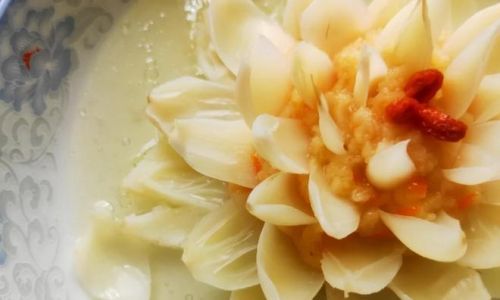Table of content
Lily bulbs, scientifically known as Lilium lancifolium or Lilium brownii, have been a staple in traditional medicine and culinary practices across Asia for centuries. Revered for their delicate flavor and potential health benefits, these bulbous vegetables are often incorporated into soups, stews, and stir-fries. However, as with many natural remedies, questions arise about safe consumption levels. One common inquiry is: How many lily bulb slices should one eat at a time? This article explores the nutritional profile of lily bulbs, their traditional uses, safety considerations, and expert-recommended guidelines for dosage.
Understanding Lily Bulbs: Nutritional Value and Traditional Uses
Lily bulbs are low in calories but rich in essential nutrients. A 100-gram serving of raw lily bulbs contains approximately:
- 96 calories
- 3 grams of dietary fiber
- 11 grams of carbohydrates
- 3 grams of protein
- Vitamins B1, B2, and C
- Minerals such as potassium, phosphorus, and calcium
Beyond their nutritional content, lily bulbs are prized in traditional Chinese medicine (TCM) for their purported ability to nourish the lungs, soothe the throat, and calm the spirit. They are often prescribed to alleviate coughs, reduce anxiety, and promote restful sleep. Modern research has also explored their antioxidant properties, which may combat oxidative stress and inflammation.
Despite these benefits, lily bulbs contain natural alkaloids, such as colchicine, which can be toxic in large doses. This duality underscores the importance of moderation and proper preparation.

Safety Considerations: Risks of Overconsumption
While lily bulbs offer health advantages, excessive intake can lead to adverse effects. Raw or improperly prepared bulbs may cause:
- Gastrointestinal distress: Nausea, vomiting, or diarrhea.
- Neurological symptoms: Dizziness, confusion, or in severe cases, paralysis.
- Allergic reactions: Itching, hives, or swelling in sensitive individuals.
To mitigate these risks, lily bulbs must be thoroughly cooked. Boiling, baking, or stir-frying breaks down harmful compounds, making them safe for consumption. Pregnant women, individuals with kidney disorders, or those taking immunosuppressant medications should consult a healthcare provider before incorporating lily bulbs into their diet.
Recommended Dosage: How Much Is Too Much?
The optimal dosage of lily bulbs depends on factors such as age, health status, and preparation method. Here’s a breakdown of general guidelines:
Fresh Lily Bulbs
- Adults: 10–15 grams per serving (equivalent to 3–5 thin slices).
- Children (aged 6–12): 5–7 grams (1–2 slices).
- Frequency: No more than 2–3 servings per week.
Dried Lily Bulbs
Dried bulbs are more concentrated, so smaller portions are advised:
- Adults: 3–5 grams per serving (approximately 1–2 teaspoons of sliced dried bulbs).
- Children: Avoid or use under strict medical supervision.
Powdered or Supplement Form
If consuming lily bulb extracts or capsules, adhere to the manufacturer’s instructions. Typically, doses range from 300–500 mg daily, split into two servings.

Factors Influencing Dosage
-
Age and Health Status:
- Elderly individuals or those with chronic conditions may require lower doses.
- Children should avoid lily bulbs due to their delicate digestive systems.
-
Method of Preparation:
- Boiling reduces toxicity more effectively than stir-frying.
- Soaking dried bulbs in water for 2–3 hours before cooking enhances safety.
-
Combination with Other Foods/Herbs:
Pairing lily bulbs with complementary ingredients like lotus seeds or jujube dates may enhance benefits without increasing dosage.
-
Individual Tolerance:

Start with a small amount (e.g., 1–2 slices) and monitor for adverse reactions.
How to Prepare Lily Bulbs Safely
Proper preparation is critical to reducing toxicity. Follow these steps:
- Peel and Slice: Remove the outer scales and fibrous roots. Slice the bulb into thin, uniform pieces.
- Soak: Immerse sliced bulbs in cold water for 30 minutes to leach out bitter compounds.
- Boil: Simmer in plenty of water for 15–20 minutes. Discard the water afterward.
- Cook Thoroughly: Use in recipes like lily bulb and chicken soup or stir-fried with vegetables.
Potential Side Effects and When to Seek Help
Even when prepared correctly, some individuals may experience mild side effects:
- Upset stomach: Reduce portion sizes or discontinue use.
- Skin irritation: Avoid contact with raw bulb juice; wear gloves during preparation.
If symptoms like severe abdominal pain, rapid heartbeat, or difficulty breathing occur, seek immediate medical attention.
Expert Opinions and Studies
According to a 2021 study published in the Journal of Ethnopharmacology, moderate lily bulb consumption (10–15 grams daily) showed no adverse effects in healthy adults. However, researchers cautioned against exceeding 30 grams per day due to elevated alkaloid levels.

Dr. Elena Chen, a TCM practitioner based in Beijing, emphasizes: “Lily bulbs are a powerful remedy when used judiciously. Overindulgence disrupts the body’s balance, so always prioritize moderation.”
Frequently Asked Questions
Q: Can I eat lily bulbs raw?
A: No. Raw consumption increases the risk of toxicity. Always cook them thoroughly.
Q: Are canned lily bulbs safe?
A: Commercially canned products are typically pre-cooked and safe, but check labels for additives.
Q: How long do cooked lily bulbs last?
A: Store in an airtight container in the refrigerator for up to 3 days.
Q: Can pets consume lily bulbs?
A: No. Lily bulbs are toxic to cats and dogs.

Conclusion: Balancing Benefits and Risks
Lily bulbs offer a unique blend of culinary appeal and potential health benefits. However, their safety hinges on mindful preparation and dosage. For most adults, 3–5 fresh slices or 1–2 teaspoons of dried bulbs, consumed 2–3 times weekly, strike an optimal balance. As always, consult a healthcare provider before making significant dietary changes, especially if pregnant, nursing, or managing a health condition.
By respecting traditional wisdom and modern safety guidelines, lily bulbs can remain a cherished addition to global cuisine and wellness practices. Remember: moderation is the key to harnessing nature’s gifts without inviting harm.




0 comments